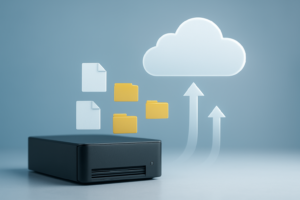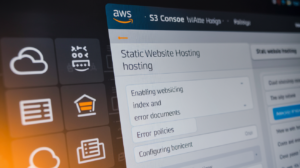Ever wondered why top tech companies are ditching traditional servers faster than last season’s smartphone? Because serverless architecture is changing everything about how we build and scale applications.
Serverless doesn’t mean “no servers” – it means you never have to think about them again. You write code, it runs when needed, and you pay only for what you use. That’s it.
The days of provisioning servers, worrying about capacity planning, and waking up to 3AM alerts about CPU spikes are over. Serverless architecture lets developers focus exclusively on creating value through code.
But here’s what most tutorials won’t tell you about serverless: it’s not just about simplifying deployment – it’s completely redefining what’s possible in application development.
What is Serverless Architecture?
The Evolution from Traditional Servers to Serverless
Remember when we had to buy physical servers just to run a website? Those days feel ancient now. Back then, companies maintained entire server rooms with blinking lights and constant air conditioning.
Then virtualization hit the scene, letting us run multiple workloads on a single server. This was progress, but we still had to provision and maintain those virtual machines.
Next came the cloud revolution. AWS, Azure, and Google Cloud let us rent servers by the hour instead of buying them outright. Better, but we were still managing servers—just someone else’s.
Serverless flips this model on its head. Instead of thinking about servers at all, you just upload your code and the cloud provider handles everything else. No more:
- Capacity planning
- Operating system updates
- Security patches
- Scaling configurations
Your code simply runs when needed and you pay only for what you use. It’s like switching from owning a car to using an Uber—only when you need it, with none of the maintenance headaches.
Core Principles and Benefits of Going Serverless
Serverless isn’t just a tech choice—it’s a mindset shift with some serious upside.
First, you get true pay-per-use pricing. Your functions might cost fractions of a penny per execution. No more paying for idle servers just in case traffic spikes.
Auto-scaling happens instantly. Whether you get 10 or 10,000 simultaneous requests, the platform handles it without you lifting a finger.
Developer productivity skyrockets because you focus solely on writing application code. All the infrastructure headaches? Gone. Your team ships features faster since there’s less to configure and manage.
Operational overhead drops dramatically too. No more midnight alerts about server crashes or disk space running low.
But perhaps the biggest win is how serverless pushes you toward better architecture. By forcing you to build in small, discrete functions, you naturally create more modular, maintainable code.
Key Players in the Serverless Market
The serverless landscape is dominated by the major cloud providers, each with their own flavor:
AWS Lambda leads the pack as the pioneer that launched in 2014. It supports numerous languages and integrates seamlessly with the AWS ecosystem.
Azure Functions offers tight integration with Microsoft’s services and excellent .NET support.
Google Cloud Functions excels at performance and has first-class support for event-driven architectures.
IBM Cloud Functions (based on Apache OpenWhisk) provides an open-source option with solid enterprise features.
But it’s not just about the big cloud providers. Platforms like Vercel and Netlify have built specialized serverless offerings focused on frontend deployment and Jamstack applications.
For companies concerned about vendor lock-in, frameworks like Serverless Framework and AWS SAM offer ways to standardize deployments across providers.
The market keeps evolving, with specialized tools emerging for debugging, monitoring, and optimizing serverless applications. As adoption grows, expect to see even more innovation in this space.
How Serverless Computing Works
Function as a Service (FaaS) Explained
Think of FaaS as the backbone of serverless architecture. It’s what makes the magic happen.
With FaaS, developers simply upload their code as individual functions—small, single-purpose pieces of code that do one thing well. The cloud provider handles everything else. You don’t worry about servers, scaling, or infrastructure. You just write code that runs when needed.
Popular FaaS offerings include AWS Lambda, Azure Functions, and Google Cloud Functions. Each function sits dormant until triggered, then springs to life, does its job, and goes back to sleep.
function handleNewUser(userData) {
// Create user record
// Send welcome email
// Log signup event
return success;
}
That’s it. No server configuration, no capacity planning. Just pure business logic.
Event-Driven Execution Model
Serverless is all about reacting to events. Something happens, code runs. Simple as that.
These events could be:
- HTTP requests hitting an API endpoint
- Files uploaded to storage
- Database changes
- Scheduled timers
- Messages from queues
Your functions only wake up when these events occur. No event? No execution. No execution? No cost.
It’s like having a light that only turns on when someone enters the room. Why keep it burning when nobody’s there?
Automatic Scaling Capabilities
Here’s where serverless truly shines. Need to handle one request per hour? No problem. Suddenly hit with 10,000 requests per second? Also no problem.
The platform automatically creates as many instances of your function as needed to handle incoming events. Each request gets its own isolated environment.
No more:
- Provisioning extra servers “just in case”
- Scrambling to scale up during traffic spikes
- Paying for idle capacity
The system scales from zero to hero and back again, completely on its own.
Pay-Per-Use Pricing Structure
The serverless billing model is refreshingly straightforward: you pay only for what you use.
Costs typically include:
- Number of executions
- Execution duration
- Memory allocated
Gone are the days of paying for 24/7 server uptime when your app is only busy during business hours. If your function runs for 100 milliseconds, you pay for 100 milliseconds—not for the other 86,399,900 milliseconds in the day when it’s doing nothing.
For startups and variable workloads, this can mean savings of 80-90% compared to traditional always-on server models.
Key Benefits of Adopting Serverless Architecture
A. Reduced Operational Costs and Management
Gone are the days of stressing over server provisioning and maintenance. With serverless architecture, you’re paying only for what you use – down to the millisecond. No more wasted resources sitting idle.
Most teams don’t realize they’re spending thousands monthly on servers running at 20% capacity. Serverless eliminates this waste entirely. You run code, you pay. Code stops, billing stops. Simple as that.
The cost difference? Dramatic. A typical application that might cost $1,000/month on traditional servers often drops to $300 or less on serverless – that’s 70% savings straight to your bottom line.
B. Enhanced Developer Productivity
Developers waste precious hours configuring infrastructure instead of building features. Serverless changes the game completely.
With serverless, your team focuses exclusively on code that delivers business value. No more SSH sessions into servers at midnight. No more debugging mysterious environment issues.
A senior developer put it perfectly: “Serverless gave me back 40% of my workweek – time I now spend actually solving problems instead of babysitting servers.”
C. Built-in Scalability Without Configuration
The scalability struggle is real. Your traditional application needs complex load balancing, instance groups, and auto-scaling policies that never quite work right.
Serverless platforms handle this automatically. Your application scales from one user to millions without you changing a single line of code or configuration.
During Black Friday 2022, an e-commerce site using serverless handled 8,700% more traffic than normal without a hitch. Their competitors? Server crashes and lost sales.
D. Faster Time to Market for Applications
Speed wins in today’s market. Serverless dramatically shrinks development cycles.
By eliminating infrastructure management, teams typically ship features 30-50% faster. A banking app that would take 6 months to deploy on traditional architecture launched in just 8 weeks with serverless.
The math is simple: faster deploys = faster feedback = better products.
E. Improved Fault Tolerance and Reliability
Downtime hurts. It costs money, reputation, and customer trust.
Serverless architectures shine here with redundancy built into their DNA. Your functions run across multiple availability zones automatically. If one data center has issues, your application keeps running without missing a beat.
Companies report 99.99% or better uptime after switching to serverless – a massive improvement over the typical 98-99% with self-managed infrastructure.
The reliability difference isn’t just technical – it’s transformative for businesses that can now promise true 24/7 availability without the traditional operations headache.
Common Serverless Use Cases
API Development and Microservices
Serverless shines when building APIs and microservices. Think about it – you’re free from managing the underlying infrastructure while focusing on what matters: your code.
With serverless, each API endpoint can be a separate function, triggered when a request comes in. This granular approach means you pay only for actual usage and can scale each endpoint independently based on demand.
GET /users → Lambda Function A
POST /orders → Lambda Function B
Teams building modern apps love this because they can deploy and update individual endpoints without touching the entire application. A bug fix for the payment API? Deploy just that function without risking the rest of your system.
Real-Time File Processing
Ever uploaded a photo and wondered how it gets resized, compressed, or analyzed instantly? That’s serverless at work.
When a user uploads a file to your storage (like S3), it triggers a serverless function that processes the file immediately. No servers waiting idle between uploads.
Common examples include:
- Image resizing for thumbnails
- Video transcoding
- PDF generation
- Data extraction from documents
The beauty is that your processing capacity scales automatically with demand. Got 10 uploads or 10,000? The cloud provider handles the scaling for you.
Scheduled Tasks and Cron Jobs
Remember the days of setting up dedicated servers just to run scheduled jobs? Those days are gone.
Serverless platforms let you schedule functions to run at specific times without provisioning infrastructure. From daily database backups to sending weekly newsletters, you simply define when your code should run.
IoT Applications and Data Processing
IoT devices generate massive amounts of data in unpredictable bursts. Serverless is perfect for this scenario.
Your temperature sensors might send readings every minute, but your moisture sensors only when conditions change. Serverless functions wake up only when needed to process this data, then go dormant, saving you money while handling variable workloads efficiently.
Challenges and Limitations to Consider
Cold Start Performance Issues
Serverless comes with a trade-off you’ll feel immediately: cold starts. When your function hasn’t been used for a while, the cloud provider puts it to sleep. Then when a new request comes in—boom—your users are stuck waiting while the provider spins up a new container.
This delay can range from a few hundred milliseconds to several seconds depending on your runtime, code size, and provider. For user-facing applications, that’s an eternity.
Some real-world problems this causes:
- API responses that make users think your app is broken
- Inconsistent performance that’s hard to explain to stakeholders
- Higher bounce rates on critical pages
Quick fix? Keep your functions “warm” with scheduled pings, but that feels like cheating the serverless model, doesn’t it?
Debugging and Monitoring Complexities
Ever tried finding a needle in a haystack? That’s debugging serverless apps. With functions scattered across the cloud and no direct server access, troubleshooting becomes a nightmare.
Traditional debugging approaches fall apart here. You can’t just SSH into a server and check logs or run diagnostics. Instead, you’re at the mercy of whatever monitoring tools your provider offers.
The distributed nature makes things worse. A single user request might trigger 5-10 different functions, and tracking the flow between them requires specialized observability solutions.
And costs? Logging everything can get expensive fast. Many teams end up with a painful choice: comprehensive monitoring or reasonable cloud bills.
Vendor Lock-In Concerns
The serverless world has a dirty secret: once you’re in, you’re IN. Each provider has their own:
- Function configuration formats
- Event triggers and schemas
- Deployment pipelines
- Integration points with other services
Moving from AWS Lambda to Azure Functions isn’t just a copy-paste job—it’s a substantial rewrite. Your carefully crafted infrastructure becomes a tangled web of provider-specific services.
This lock-in comes with real business risks. What happens when your provider raises prices? Changes their service terms? Deprecates features you depend on?
Frameworks like Serverless Framework and Terraform help abstract some differences, but they’re band-aids on a deeper architectural challenge.
Resource and Runtime Limitations
Serverless isn’t limitless—despite what the name suggests. You’ll bump into hard constraints:
- Execution timeouts (typically 5-15 minutes max)
- Memory limits (often capped at 1-3GB)
- Temporary storage restrictions
- Package size limitations
These boundaries force uncomfortable architecture decisions. That data processing job that occasionally needs 20 minutes to run? You’ll need to chunk it or move it elsewhere.
Language support is another headache. While most providers cover popular languages, version control lags behind. Want to use the latest Node.js features? You might be waiting months after release.
Then there’s concurrency limits—the maximum number of function instances running simultaneously. Hit that ceiling, and your app starts dropping requests during traffic spikes, precisely when reliability matters most.
Building Your First Serverless Application
Choosing the Right Serverless Provider
Ready to dive into serverless? Your first big decision is picking a provider. The market has several heavy hitters:
- AWS Lambda – The pioneer with the widest range of integrations
- Azure Functions – Microsoft’s answer with tight Office 365 integration
- Google Cloud Functions – Excels at machine learning workloads
- Cloudflare Workers – Super fast with edge computing capabilities
Don’t just go with what’s popular. Think about what your app needs. Using lots of AWS services already? Lambda might be your best bet. Need tight integration with Microsoft products? Azure Functions could be your friend.
Pricing models matter too. Most charge based on execution time and memory usage, but the details vary wildly.
Setting Up Your Development Environment
Getting your local setup right makes serverless development much smoother. You’ll need:
- A good code editor (VS Code is popular for this)
- The provider’s CLI tools
- A local serverless emulator
Install the Serverless Framework or AWS SAM to manage deployments. They’re game-changers:
npm install -g serverless
Then set up local testing. Nothing’s worse than deploying to the cloud just to find a basic bug:
serverless invoke local --function myFunction
Deploying and Testing Functions
Deployment with serverless is ridiculously simple. With the Serverless Framework, it’s often just:
serverless deploy
But the real magic happens when you set up CI/CD pipelines. GitHub Actions or AWS CodePipeline can automatically test and deploy your functions whenever you push code.
Testing serverless apps requires a different mindset. Unit tests work as usual, but integration testing gets tricky. Tools like AWS SAM Local or the Serverless Offline plugin let you test your functions locally before they hit the cloud.
Log everything. Seriously. Cloud-based debugging is different from traditional debugging, and good logs are your best friend.
Connecting to Data Sources and External Services
Serverless functions shine when connected to other services. Common pairings include:
- DynamoDB or MongoDB for NoSQL data
- S3 or Blob Storage for files
- SQS/SNS for messaging
When connecting to databases, remember that serverless functions may create many concurrent connections. Connection pooling doesn’t work the same way it does in traditional apps.
For external APIs, handle rate limiting and timeouts gracefully. Your functions might scale faster than the APIs you’re calling can handle.
Implementing Authentication and Security
Security in serverless requires special attention. Some quick wins:
- Use your provider’s IAM roles to restrict function permissions
- Never store secrets in your function code (use parameter stores instead)
- Set appropriate timeouts and memory limits
For user authentication, services like Auth0, AWS Cognito, or Firebase Auth integrate nicely with serverless apps.
Don’t forget about cold starts! They can affect security operations by increasing latency during token validation. Consider caching mechanisms for frequently used credentials or tokens.
API Gateways often handle the first line of defense. Configure them properly with throttling, request validation, and proper CORS settings.
Best Practices for Serverless Architecture
Optimizing Function Performance
Serverless might seem fast by default, but poorly written functions can still crawl. Here’s how to make your serverless functions lightning quick:
-
Cold starts are killing you. Minimize them by keeping your function code small and dependencies lighter than a feather. Do you really need that entire AWS SDK when you’re only using S3?
-
Memory matters more than you think. Bumping up allocated memory doesn’t just prevent out-of-memory errors—it often gives you more CPU power too. That 128MB function might be penny-wise but performance-foolish.
-
Lazy loading is your friend. Only initialize what you need when you need it. Your function doesn’t need to connect to that database if the request is just a health check.
// Instead of this at the top level
const heavyDependency = require('massive-library');
// Do this inside your handler
function handler(event) {
// Only load when needed
const heavyDependency = require('massive-library');
}
Managing State in a Stateless Environment
Serverless functions have amnesia—they forget everything between invocations. Here’s how to deal with that:
-
External state services are non-negotiable. Redis, DynamoDB, or any managed database should handle your persistent data needs.
-
Connection pooling doesn’t work like you think. Each concurrent execution gets its own pool, so careful with those database connections.
-
Consider local caching for repeated invocations. Some providers keep your container warm for a bit, so you can cache results in memory for quick reuse:
// Module-level cache can persist between warm invocations
const cache = {};
exports.handler = async (event) => {
const key = event.id;
if (cache[key]) return cache[key];
const result = await expensiveOperation();
cache[key] = result;
return result;
};
Implementing Effective Error Handling
Errors in serverless are sneakier than usual—they can hide in logs you’re not checking or vanish entirely.
- Wrap everything in try/catch blocks. I mean everything:
async function handler(event) {
try {
// Your entire function logic here
} catch (error) {
console.error('Function failed:', error);
// Structured error response
return {
statusCode: 500,
body: JSON.stringify({
error: 'Something went wrong',
requestId: event.requestId
})
};
}
}
-
Dead letter queues save lives. Configure them for async functions so failed events have somewhere to go besides the void.
-
Retries need backoff strategies. Exponential backoff prevents thundering herds when downstream services fail.
Designing for Cost Efficiency
Serverless can be dirt cheap or surprisingly expensive. The difference? Smart design.
-
Function duration is money leaving your pocket. Optimize ruthlessly—every 100ms matters when you’re running at scale.
-
Batch processing saves cash. Why process one record at a time when your function could handle 100 for nearly the same cost?
-
Right-size your memory settings. Test different configurations—sometimes more memory costs less because functions finish faster.
-
Watch for hidden costs. Data transfer, API Gateway requests, and provisioned concurrency can dwarf your function execution costs if you’re not careful.
Serverless architecture represents a transformative approach to cloud computing, empowering developers to focus on code rather than infrastructure management. Throughout this guide, we’ve explored how serverless works, its compelling benefits including cost efficiency and automatic scaling, and practical use cases from web applications to data processing pipelines. While challenges like cold starts and vendor lock-in exist, the advantages often outweigh these limitations for many applications.
As you begin your serverless journey, remember to follow best practices: design with statelessness in mind, optimize function execution times, and implement proper monitoring. The serverless paradigm continues to evolve rapidly, offering increasingly sophisticated tools to build resilient, scalable applications. Whether you’re developing a simple API or a complex enterprise solution, serverless architecture provides a powerful foundation for building modern applications without the operational burden of traditional server management.




















